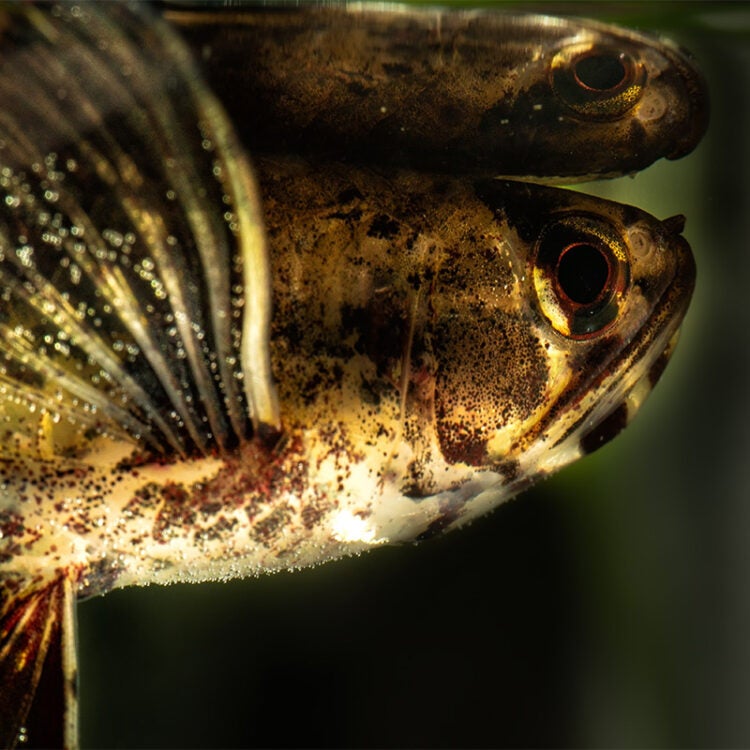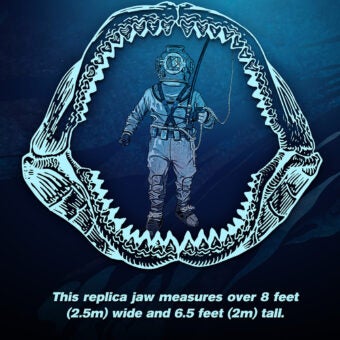-
Size
2-4 inches (5-10 cm) -
Diet
Terrestrial insects, aquatic larvae, crustaceans and fish -
Range
Africa -
Habitat
Upper surface of open water
Physical Characteristics
- The body is compressed with a large, upward-facing mouth with a prominent lower jaw and numerous teeth. Large, flat eyes sit high on the head.
- Eye placement allows the African butterfly to see both above and below the water’s surface at the same time.
- Enlarged pectoral fins that extend outward. Ventral fins are thread-like and project down below the body while the caudal and anal fins are large and broad.
- Coloration consists of brown, gray or olive, all with a silver sheen.
- Often have dark markings on their fins and underside.
- Average size is 2-4 inches (5-10 cm). Maximum recorded length of 5.9 inches (15 cm).
Animal Fun Fact
The African butterflyfish is a powerful jumper and is known to jump out of the water to catch insects or to escape predators.
Diet / Feeding
- Insectivore; diet consists of on terrestrial insects, aquatic larvae, nymphs of insects, crustaceans and fish.
- Efficient ambush predator.
- Known to eat terrestrial insects that fall to the surface of the water or are situated on low branches or leaves.
- Powerful jumper. Known to jump out of the water to catch insects or to escape predators.
- Uses its large, broad caudal fin to propel itself out of the water.
Range / Habitat
- Occurs in western, central and eastern Africa.
- Western and central Africa includes Nigeria, Lake Chad, Cameroon, Ogowe basin, Congo basin and upper Zambezi River.
- Eastern Africa includes the Ouémé River in Benin.
- Inhabits the upper strata of open water in swamps, creeks, ponds and backwaters of streams and rivers with dense amounts of surface floating vegetation.
Reproduction & Growth
- Oviparous; egg-laying species that are egg-scatterers.
- Eggs are opaque white and immediately rise to the water surface. After 24 hours, they turn dark and start to sink.
- Eggs take several days to hatch.
- Spawning occurs after much chasing of the female by the male.
- Spawning will precede over a period of several days in which typically over 100 eggs per day are released and fertilized.
- No parental care for the fry.
- When first born, the fry are not very mobile and are not good hunters but once they learn to find food, they grow quickly.
Conservation Status
- Listed as “Least Concern” on the IUCN Red List.
Additional Information
- Also known as the “Freshwater Butterflyfish.”
- The “butterfly” in its name comes from what it looks like from above; the widespread pectoral fins resemble butterfly wings.
- These butterfly-like pectoral fins help with camouflage, making the fish look like a dead leaf floating on the water’s surface.
- Potamodromous; migrates within fresh water.
- Top-dwelling species that swims just beneath the water’s surface.
- Have sensors that detect small waves in the water caused by insects hitting the water’s surface.
- Commonly rest with the top of the head and large pectoral fins touching the surface, while the long strands of pelvic fin hang down perpendicularly.
- Ability to breathe atmospheric air.
- Seek out floating structures, particularly plants, as they may harbor prey and can also serve as protection from birds.
- Movements are usually slow and deliberate to avoid detection by predators or prey, but they do have the ability to move quickly when attacking prey.
- Said to have survived, unchanged, for 100 million years giving them the nickname “living fossils.”
- Often found individually or in a pair.
- Harmless to humans.







